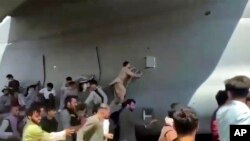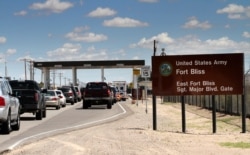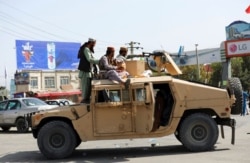A day after the Afghan capital fell to the Taliban without a fight, U.S. and other foreign forces continue to protect and hold Kabul's international airport, where panicked crowds have fled to seek refuge from the Taliban.
Pentagon press secretary John Kirby told reporters Monday at the Pentagon that air traffic at Hamid Karzai International Airport was halted for hours amid the hectic security situation, preventing more U.S. troops from arriving to bolster security and more evacuees from leaving.
Video from the airport shared on social media showed disorder and desperation, including one of Afghans clinging to the sides of a U.S. military aircraft, and another of what appeared to be a person falling from a U.S. military plane after it took off.
The Pentagon has confirmed at least two deaths at the airport. Two armed gunmen fired into the crowds in two separate incidents, and both were killed by U.S. forces acting on a "real and tangible threat," Kirby said.
"We don't have any indications that they were Taliban," he added.
A U.S. official who spoke to VOA on the condition of anonymity also said reports of multiple civilian deaths during the takeoff of a U.S. military transport plane were "currently under investigation."
“You’re getting information that I don’t have,” Kirby replied to VOA when asked about the investigation, “but it wouldn’t surprise me in the least that commanders would be taking a look at what happened this morning with respect to the C-17.”
General Frank McKenzie, head of U.S. Central Command, met Sunday with the Taliban in Qatar and warned them that the U.S. military would use self-defense should the militant group try to interfere with the massive evacuation mission, according to senior defense officials.
Asked how many C-17 transport aircraft were being utilized to fly people out of Afghanistan, one senior defense official replied, "every one that's available."
The U.S. has approved about 6,000 troops to assist with security and evacuations on the ground, more than double the number of American troops in Afghanistan when the withdrawal was announced in May.
Major General William “Hank” Taylor, the U.S. Joint Staff’s deputy director for regional operations and force management, told reporters Monday that 3,000-3,500 U.S. troops were expected on the ground at the airport by the end of the day.
NATO on Sunday also began focusing its efforts on the airport, though it said it was also seeking to maintain a diplomatic presence in Kabul.
The U.S. military is now assessing two additional military facilities in the U.S. — Fort Bliss in the state of Texas and Camp McCoy in the state of Wisconsin — to house up to 22,000 at-risk Afghan nationals in the coming weeks. Afghans who helped U.S. military forces and diplomats, mostly as interpreters and drivers, have already been arriving at Fort Lee in the state of Virginia.
Meanwhile, concern is growing about what is to come for Afghan troops who defended their nation against the Taliban.
“Many of us have spent time in Afghanistan over the years and feel a deep sense of connection to the current events,” Taylor said at Monday’s briefing.
Afghan Colonel Rahman Rahmani, a pilot currently studying in the U.S., said via Twitter that the Taliban were going door to door killing Afghan special operators and Afghan pilots.
He says his house was taken by “terrorists,” and his mother and five siblings are trapped in the country.
“The West left us with betrayal,” he said.
Swift fall
Taliban insurgents led Afghanistan from 1996 to 2001, when they were overthrown by U.S. and international forces.
Recently, they seized most of the country in a matter of weeks after launching a swift military campaign that caused many Afghan forces to flee or surrender.
In an interview Monday with VOA Persian, Vali Aria, a London-based Afghan security analyst and former adviser to NATO, blamed “out-of-control corruption,” a “lack of leadership in the higher ranks” and “incompetence in the (Afghan) government” for the Afghan forces’ rapid fall.
“This corruption created frustration and a lack of motivation amongst the ranks of the security and defense forces in Afghanistan. They lost their spirit to fight,” Aria said.
He added, “The other problem pertains to the politicization of ethnicity. It had a big effect on the style of governance. Only in rare cases would we see (Afghan) governance based on merit. Therefore, troops on the front lines, upon seeing these problems, would question themselves and say, ‘Now that the U.S. and the world community have decided to leave Afghanistan, why should we fight?’"
The last U.S. airstrike in Afghanistan was “several days ago,” Kirby told reporters on Monday. Asked by VOA why the U.S. was conducting fewer strikes against the Taliban than the smaller, less experienced Afghan military in response to Taliban advances, Kirby said American “resources and capabilities” had dwindled because of the drawdown, “which meant we had fewer airplanes, fewer strike capabilities.”
“We were very transparent about the fact that we would conduct airstrikes in support of the Afghans, where and when feasible, fully cognizant of the fact that it wasn't always going to be feasible in every — on every day and in every place,” he said.
VOA Persian's Payam Yazdian contributed to this report.











